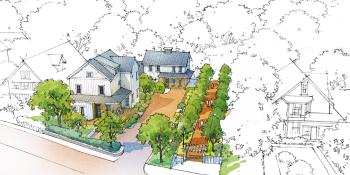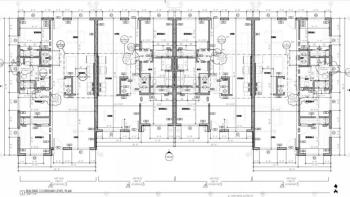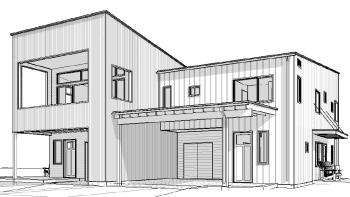
Recognizing innovative design solutions
Winners of the 2023 annual Habitat House Design Contest
Habitat for Humanity designs homes that are as unique, creative and strong as the people who live in them. Whether it’s creating veteran-inclusive spaces in New Jersey, maximizing land use in California or constructing hurricane-resistant residences in Florida, Habitat affiliates in the U.S. design innovative homes to best serve their communities.
The annual Habitat House Design Contest, generously sponsored for a third year by Simpson Strong-Tie, recognizes Habitat affiliates for their excellence in design across a range of categories, including accessibility, affordability, durability and many more.
Read on to learn more about the 2023 winning designs.

Design of the Year: Achieving new lows in energy efficiency
In 2022, the average American home scored a 58 on the Home Energy Rating System, a standard that assesses residential energy efficiency. Dallas Area Habitat built a home that earned a HERS score of -13, meaning the home is putting more energy back onto the power grid than it is consuming.
Carmen Holmes, Dallas Area Habitat’s senior vice president of development, says the affiliate achieved this by using eco-friendly design features, including advanced foam insulation, solar panels on the roof and smart window configuration to maximize natural light.
The home’s energy-efficient design will potentially help the homeowner save significantly on utility bills each year, freeing the family to invest in other areas of their lives.

Best in Accessibility: Helping homeowners age in place
The rugged, mountainous landscape in Asheville, North Carolina, has forced developers to build multi-level homes on steep grades. As a result, the city’s housing stock is often not suitable for aging adults. Asheville Area Habitat launched its Aging in Place program in 2019 to build accessible homes that enable older adults to “stay in their homes as long as possible,” says Sumaya El-Attar, the affiliate’s construction administrator.
The affiliate worked with an architecture company to design a one-bedroom, single-story townhome with wide doors, an accessible bathroom and several turnabouts for wheelchairs to easily maneuver around the home. The model is set aside for residents who are at least 55 years old.
The first eight of these townhomes were built in Asheville Area Habitat’s New Heights neighborhood, a diverse 20-acre community that will be home to 97 homes of varying designs when construction is complete.
Best in Multifamily: Maximizing space and building with density in mind
The San Francisco Bay Area experiences a host of affordable housing challenges, including high construction costs and limited availability of undeveloped land. “It’s hard not to be emotional about the housing crisis in California,” says Melanie Mintenko, project manager at Habitat East Bay/Silicon Valley. “The idea of homeownership is well beyond reach for many people.”
Esperanza Place, the affiliate’s new multi-family development in Walnut Creek, California, will bring 42 affordable units to an area with a dire shortage of affordable housing options. Phase 1 is scheduled for completion in 2024, and the entire development is expected to be finished in early 2026. The project will include a mix of energy-efficient one- to four-bedroom apartments ranging from 800 to 1,400 square feet. The 2-acre property abuts an expansive recreational trail and is within walking distance to a transit center, hospital, schools, restaurants and shops.
Melanie says building with density in mind is the best way to expand affordable homeownership opportunities in the region. “In an area like this, where there isn’t a lot of space left to do new construction, the more density we can fit in, the better.”

Best in Sustainability: Revitalizing an aging property
Habitat Greater Boston is partnering with Adaptiv, a local planning and architecture nonprofit, to reimagine an aging property in the city’s Roslindale neighborhood. The two organizations are repurposing an existing single-family house into two units and building a second two-family home in the back of the property. Construction is underway on the four units, which will feature solar panels, electrical heat pumps and energy recovery ventilators to maximize energy efficiency.
While Habitat Greater Boston and Adaptiv focus on building the sustainable homes, the city of Boston is constructing a boardwalk adjacent to the homes to connect the neighborhood directly to the Roslindale Wetlands, a public wetland bordering the property. The project included extensive input from the community, who advocated for the redevelopment to include affordable housing and a walkway to the urban wild.

Affiliate Choice: An eco-friendly alternative to concrete
Concrete is one of the construction materials with the highest carbon footprint in the building industry. Greater Jackson Habitat’s quest to build a carbon-neutral home meant the affiliate had to find an alternative to building the foundation with concrete. David Behnke, Greater Jackson Habitat’s construction director, explains that the Michigan affiliate designed a wood foundation that sits atop strong, compacted cut stone. A sturdy foam layer is then laid on the wood foundation to further fortify the flooring structure.
This alternative reduces the environmental footprint of construction while still adhering to Habitat’s high standard for quality homebuilding. “We want to be all green. The younger generation is concerned about what’s going to be down their path. We build these houses so that they’ll be here for 150 years,” David says.

Best in Hazard: Preparing for a disaster
Habitat of the Middle Keys in Marathon, Florida, built eight new affordable homes designed to withstand Category 5 hurricanes and sustained winds of up to 181 miles per hour. The duplex-style homes are all-concrete and elevated more than 12 feet off the ground. They’re also equipped with metal roofing and strong trusses designed to protect the homes during intense storms.
“We’ve got to build as strong as we can,” says Chris Todd Young, the affiliate’s executive director. “By us taking that leap in the beginning and paying more to have the homes be resilient, we’re saving the homeowners in the long run.” The eight homes will make up the Bell Haven community, which also includes a new Habitat ReStore, the first for the affiliate.

Best in Innovation: Revamping an integral community space
When a brick fell from the Albert Lawson Veterans of Foreign Wars Hall in 2019 in Passaic, New Jersey, the VFW members called Passaic County Habitat to investigate the building’s condition. They surveyed the building and deemed the hall unsalvageable. The city, the VFW post and Passaic County Habitat came together to demolish the dilapidated structure and build a new VFW hall that would also include four affordable housing units on the second story.
Passaic County Habitat led construction on the multi-purpose building, which includes a mix of one- and two-bedroom apartments atop a spacious VFW Hall equipped with an industrial kitchen and ample meeting space. One of the homeowners is a member of the Albert Lawson VFW Post, offering him convenient access to fellow VFW members and events.

Best in Affordability: Keeping housing costs down
Despite global supply chain challenges, inflation and rising construction costs, Grand Island Area Habitat still builds at the same cost per square foot as they did in 2019. Alyssa Heagy, executive director of the Nebraska-based affiliate, says this is possible because of cost-effective changes they made to their floor plans, like eliminating wasted space.
They also keep construction costs down by partnering with the Grand Island Senior High School’s Career Pathways Institute. For the last eight years, the junior class in the construction pathway program has built a home, including this simple and affordable two-bedroom home that won Best in Affordability.

Best in Equity and Inclusion: Scaling homebuilding in an underserved neighborhood
As the city of Fort Wayne, Indiana, scales its efforts to revitalize disinvested neighborhoods, they’ve partnered with Habitat Greater Fort Wayne to accelerate affordable homebuilding. “We’re blessed and fortunate to be part of their housing solution,” says Jeff Bredemeier, director of construction.
In March 2023, the city transferred enough residential lots for the affiliate to build 32 affordable homes in Renaissance Pointe, a historically underserved neighborhood in southeast Fort Wayne. Jeff says they expect to build 16 new homes in Renaissance Pointe by May 2024, many of which will feature Habitat Greater Fort Wayne’s new four-bedroom, two-bathroom design.

Best in Durability: Building a fortified home
Habitat North Central Connecticut adapted its standard three-bedroom build to construct an ultra-durable, all-concrete home in partnership with the National Ready Mixed Concrete Association. Kris McKelvie, construction director, says the entire house was built using insulated concrete forms, a construction system that uses foam to reinforce concrete and create a strong, well-insulated structure.
This is Habitat North Central Connecticut’s first home to achieve FORTIFIED Gold status, the highest mark for the national standard for resilience. Kris says the homeowners — a single mother and her son — have “peace of mind” knowing their home is sturdy and secure.
Design of the Year: Achieving new lows in energy efficiency
In 2022, the average American home scored a 58 on the Home Energy Rating System, a standard that assesses residential energy efficiency. Dallas Area Habitat built a home that earned a HERS score of -13, meaning the home is putting more energy back onto the power grid than it is consuming.
Carmen Holmes, Dallas Area Habitat’s senior vice president of development, says the affiliate achieved this by using eco-friendly design features, including advanced foam insulation, solar panels on the roof and smart window configuration to maximize natural light.
The home’s energy-efficient design will potentially help the homeowner save significantly on utility bills each year, freeing the family to invest in other areas of their lives.
Best in Accessibility: Helping homeowners age in place
The rugged, mountainous landscape in Asheville, North Carolina, has forced developers to build multi-level homes on steep grades. As a result, the city’s housing stock is often not suitable for aging adults. Asheville Area Habitat launched its Aging in Place program in 2019 to build accessible homes that enable older adults to “stay in their homes as long as possible,” says Sumaya El-Attar, the affiliate’s construction administrator.
The affiliate worked with an architecture company to design a one-bedroom, single-story townhome with wide doors, an accessible bathroom and several turnabouts for wheelchairs to easily maneuver around the home. The model is set aside for residents who are at least 55 years old.
The first eight of these townhomes were built in Asheville Area Habitat’s New Heights neighborhood, a diverse 20-acre community that will be home to 97 homes of varying designs when construction is complete.
Best in Multifamily: Maximizing space and building with density in mind
The San Francisco Bay Area experiences a host of affordable housing challenges, including high construction costs and limited availability of undeveloped land. “It’s hard not to be emotional about the housing crisis in California,” says Melanie Mintenko, project manager at Habitat East Bay/Silicon Valley. “The idea of homeownership is well beyond reach for many people.”
Esperanza Place, the affiliate’s new multi-family development in Walnut Creek, California, will bring 42 affordable units to an area with a dire shortage of affordable housing options. Phase 1 is scheduled for completion in 2024, and the entire development is expected to be finished in early 2026. The project will include a mix of energy-efficient one- to four-bedroom apartments ranging from 800 to 1,400 square feet. The 2-acre property abuts an expansive recreational trail and is within walking distance to a transit center, hospital, schools, restaurants and shops.
Melanie says building with density in mind is the best way to expand affordable homeownership opportunities in the region. “In an area like this, where there isn’t a lot of space left to do new construction, the more density we can fit in, the better.”
Best in Sustainability: Revitalizing an aging property
Habitat Greater Boston is partnering with Adaptiv, a local planning and architecture nonprofit, to reimagine an aging property in the city’s Roslindale neighborhood. The two organizations are repurposing an existing single-family house into two units and building a second two-family home in the back of the property. Construction is underway on the four units, which will feature solar panels, electrical heat pumps and energy recovery ventilators to maximize energy efficiency.
While Habitat Greater Boston and Adaptiv focus on building the sustainable homes, the city of Boston is constructing a boardwalk adjacent to the homes to connect the neighborhood directly to the Roslindale Wetlands, a public wetland bordering the property. The project included extensive input from the community, who advocated for the redevelopment to include affordable housing and a walkway to the urban wild.
Affiliate Choice: An eco-friendly alternative to concrete
Concrete is one of the construction materials with the highest carbon footprint in the building industry. Greater Jackson Habitat’s quest to build a carbon-neutral home meant the affiliate had to find an alternative to building the foundation with concrete. David Behnke, Greater Jackson Habitat’s construction director, explains that the Michigan affiliate designed a wood foundation that sits atop strong, compacted cut stone. A sturdy foam layer is then laid on the wood foundation to further fortify the flooring structure.
This alternative reduces the environmental footprint of construction while still adhering to Habitat’s high standard for quality homebuilding. “We want to be all green. The younger generation is concerned about what’s going to be down their path. We build these houses so that they’ll be here for 150 years,” David says.
Best in Hazard: Preparing for a disaster
Habitat of the Middle Keys in Marathon, Florida, built eight new affordable homes designed to withstand Category 5 hurricanes and sustained winds of up to 181 miles per hour. The duplex-style homes are all-concrete and elevated more than 12 feet off the ground. They’re also equipped with metal roofing and strong trusses designed to protect the homes during intense storms.
“We’ve got to build as strong as we can,” says Chris Todd Young, the affiliate’s executive director. “By us taking that leap in the beginning and paying more to have the homes be resilient, we’re saving the homeowners in the long run.” The eight homes will make up the Bell Haven community, which also includes a new Habitat ReStore, the first for the affiliate.
Best in Innovation: Revamping an integral community space
When a brick fell from the Albert Lawson Veterans of Foreign Wars Hall in 2019 in Passaic, New Jersey, the VFW members called Passaic County Habitat to investigate the building’s condition. They surveyed the building and deemed the hall unsalvageable. The city, the VFW post and Passaic County Habitat came together to demolish the dilapidated structure and build a new VFW hall that would also include four affordable housing units on the second story.
Passaic County Habitat led construction on the multi-purpose building, which includes a mix of one- and two-bedroom apartments atop a spacious VFW Hall equipped with an industrial kitchen and ample meeting space. One of the homeowners is a member of the Albert Lawson VFW Post, offering him convenient access to fellow VFW members and events.
Best in Affordability: Keeping housing costs down
Despite global supply chain challenges, inflation and rising construction costs, Grand Island Area Habitat still builds at the same cost per square foot as they did in 2019. Alyssa Heagy, executive director of the Nebraska-based affiliate, says this is possible because of cost-effective changes they made to their floor plans, like eliminating wasted space.
They also keep construction costs down by partnering with the Grand Island Senior High School’s Career Pathways Institute. For the last eight years, the junior class in the construction pathway program has built a home, including this simple and affordable two-bedroom home that won Best in Affordability.
Best in Equity and Inclusion: Scaling homebuilding in an underserved neighborhood
As the city of Fort Wayne, Indiana, scales its efforts to revitalize disinvested neighborhoods, they’ve partnered with Habitat Greater Fort Wayne to accelerate affordable homebuilding. “We’re blessed and fortunate to be part of their housing solution,” says Jeff Bredemeier, director of construction.
In March 2023, the city transferred enough residential lots for the affiliate to build 32 affordable homes in Renaissance Pointe, a historically underserved neighborhood in southeast Fort Wayne. Jeff says they expect to build 16 new homes in Renaissance Pointe by May 2024, many of which will feature Habitat Greater Fort Wayne’s new four-bedroom, two-bathroom design.
Best in Durability: Building a fortified home
Habitat North Central Connecticut adapted its standard three-bedroom build to construct an ultra-durable, all-concrete home in partnership with the National Ready Mixed Concrete Association. Kris McKelvie, construction director, says the entire house was built using insulated concrete forms, a construction system that uses foam to reinforce concrete and create a strong, well-insulated structure.
This is Habitat North Central Connecticut’s first home to achieve FORTIFIED Gold status, the highest mark for the national standard for resilience. Kris says the homeowners — a single mother and her son — have “peace of mind” knowing their home is sturdy and secure.

